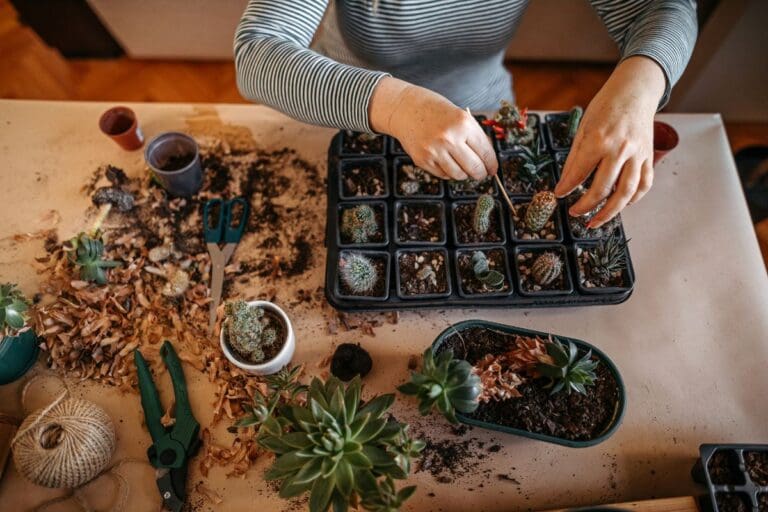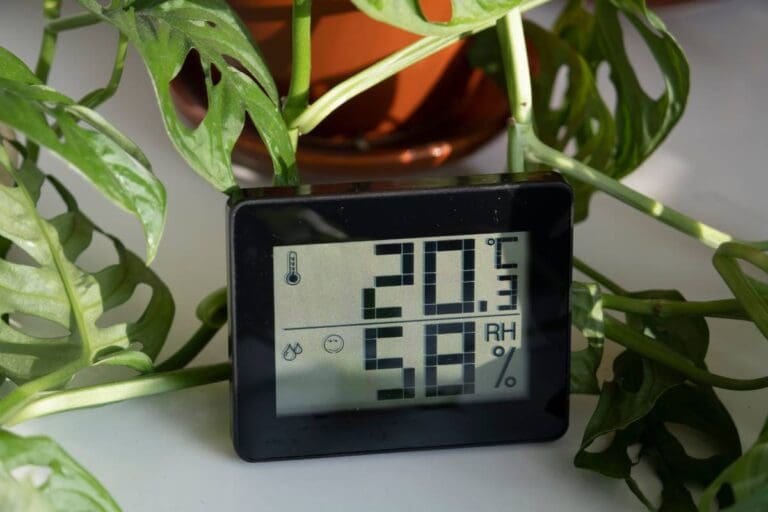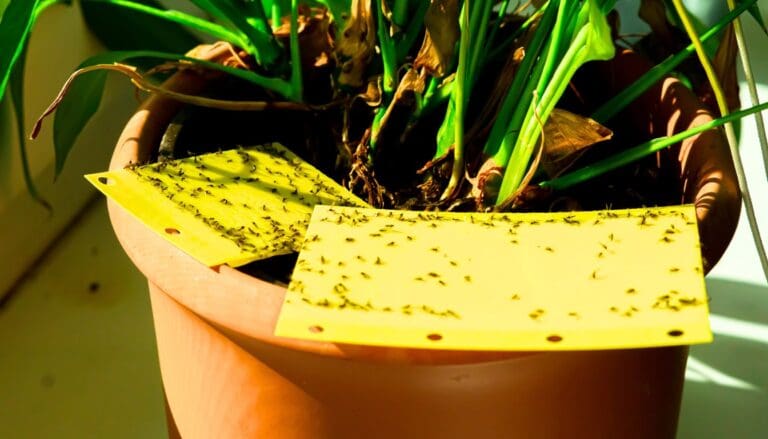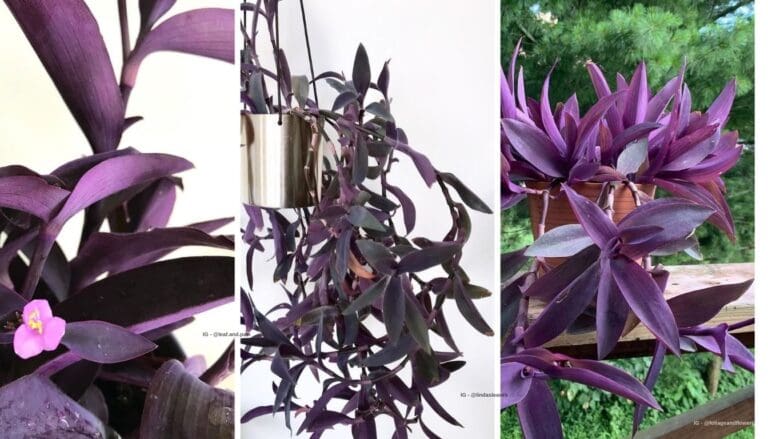Why Is My Indoor Plant Soil Not Drying? (+8 Effective Ways To Dry The Soil)
Houseplants not only add color to your space but also help in purifying the air. Even after regular care of your houseplants, the soil can get wet and soggy.
This happens mostly when you overwater your plants without checking the top layer of the soil. Wet soil for prolonged periods can give rise to many severe problems, one of them being root rot.
And a common question that comes to a gardener’s mind is why is my indoor plant soil not drying?
The common causes of indoor plant soil not drying are poor soil quality, no drainage holes, low temperatures, and low light. It is crucial to provide them with good sunlight and a well-draining soil mix to let the soil dry out. You can also use absorbents to remove all the accumulated water.
If your potting soil has more clay content, it’s possible that the soil won’t dry up quickly.
Clay tends to drain water very slowly. Garden soil sometimes contains clay, so it is better to avoid garden soil while making the potting mix for your plant.
If your houseplant’s potting soil is not drying and you are unaware of the reasons behind it, going through this article will help you understand the potential reasons behind wet soil. Along with that, we will also help you understand the ways to dry up the soil.

Please note: Simplify Plants is reader-supported. Some links in the post are affiliate links and I get a commission from purchases made through links in the post.
Causes of indoor plant soil not drying
There are various reasons why the houseplant soil takes a lot of time to dry up. Let us discuss all the possible reasons for prolonged wet soil one by one in detail.
Low light
When you water your plant, it will need bright sunlight to dry up. In low light conditions, your plants take a lot of time to dry up.
The maximum amount of water will remain in the soil without drying for long periods. Shifting them to a brighter location will help the soil to dry fast.
Even though most houseplants grow well in indirect sunlight, extreme low light conditions will stress the plant. The soil will take much more time to dry up and might develop molds.
Low temperatures
Low temperatures result in a low rate of evaporation of water in the soil. Along with evaporation, the transpiration rate would also decrease.
Due to low evaporation and transpiration, water remains in the soil for an extended period. As a result, it harms the plant and stunts its growth.
You will have to relocate your plant to a location where it will remain warm.
Also, you will have to ensure that they are not exposed to any extreme temperatures, be it high or low. The right temperature will also help you determine your plant’s water requirements, and you will be able to water them appropriately.
Poor air circulation
Another situation that causes a low rate of transpiration and evaporation is poor ventilation. Due to the lack of airflow, the soil takes a lot of time to dry up.
Keeping the plant near a fan or window from where a soothing, cool breeze enters the house will help the soil to dry up.
Poorly drained soil

Some soil material drains out excess water very slowly than the required rate. Due to this, the soil remains wet for a long time and does not dry out.
Whenever you find that after watering the plant, the water stands on the soil surface or remains muddy most of the time, the problem is with the soil.
Using ready-made soil mixes that are good at moisture retention can become poor at draining out excess water.
Using peat moss, vermiculite, perlite, or sphagnum moss will help in improving the drainage system. These ingredients have the ability to both drain and retain moisture.
Pots with no drainage holes
You might notice that even after doing everything right, the soil is still not drying up. The reason can be your pot. Some pots lack drainage holes. Mostly, the decorative pots do not have any holes.
If the pot has few or no holes, the excess water cannot flow out of the pot and stays in the potting soil. Due to this, the soil becomes waterlogged and remains wet for an extended period.
The pots need to have proper drainage holes. Or the water will remain in the soil and will not dry up well.
Too large pots
Sometimes, we use pots that are way too big for our houseplants. The soil in large pots takes forever to dry out.
Large pots contain a lot of soil that takes a lot of time to dry out. If the plant is smaller, it will take time to absorb all water from the soil.
Choose the pot size according to the size of your plant. The appropriate pot will hold the right amount of soil and will quickly absorb the water. Therefore, the soil will also dry up on time.
Also read: What happens when you put a plant in too big of a pot?
Pot material
Some pots, such as metal or plastic pots, can hold water in the soil for a long time. As a result, the soil will take a lot of time to dry out. You can try using porous pots like terracotta.
However, many pros and cons exist for pot materials. Most gardeners prefer using plastic pots because they are pretty handy. You just need to adjust the watering routine and drainage system while using plastic pots.
How to make the indoor plant soil dry?
When your potting soil takes a lot of time to dry out, it means it is soggy. Soggy soil is a sign of overwatering. This causes many other issues like yellow leaves, droopy leaves, and in worse cases, root rot diseases and pest and fungus infestations.
Let us see how to stop and fix indoor plant soil remaining wet for a long time.
Check the pot for drainage.

When you find that your soil is wet for a long time, first check for drainage holes. Water your plant well and see whether the excess water is coming out from the bottom of the pot or not, as the bottom is the place for holes.
If the water is not running out smoothly from the bottom, your pot doesn’t have enough drainage holes or doesn’t have any holes at all.
In such a case, there is no other solution than providing proper sunlight and air circulation. Other than that, repotting with a new pot that has enough holes will help solve the problem.
But you can prevent this from happening. Whenever you choose a pot, check for suitable drainage holes. If you are using decorative pots, they might not have holes, but you can make the holes by drilling.
Generally, it is recommended not to repot unless necessary, or it’s been a lot of years since last repotted. But if the pot does not have holes and your indoor plant always has wet soil, you won’t have much choice other than repotting.
Another thing you should be certain of while repotting is that you must not use an oversized pot. Always go for pots 1 to 2 sizes bigger than the existing one.
Remove stagnant water
You can try to pour out excess water from the pot to help the soil get dry fast. If your pot has a lot of water that cannot come out, it will start smelling and affecting the roots.
To know whether the soil has still water, gently tilt the pot by moving some soil away from the top.
If you see that the water is coming out and falling off the pot, there is a lot of stagnant water due to poor drainage. Keep in that position for some time to empty all the water.
Keep your plant in a sunny area.
Some plants enjoy the direct sun, whereas most prefer indirect sunlight. Sunlight helps in drying out the wet soil faster.
When you see that the potting soil is too damp, relocate your plant to a sunny area for some hours. Keeping them under the sun will also help in preventing mold and infestations.
Before relocating, consider the light requirements of your particular plant. Different plants have different needs. For increasing sunlight for your plant:
- Remove the overhead branches to ensure no obstruction in the sun’s way to reach the wet soil.
- Relocate your plant to a sunny area.
- You can keep it near a south or west-facing window to receive maximum sunlight. Do not keep your plants under the sun for too long. If your plant cannot tolerate direct, intense sun rays, create some filters to protect it.
In scorching summers, the high temperature can make the soil too dry. In such conditions, you can help the plant retain moisture by adding mulch. Mulch will help in retaining moisture and will even aerate the soil.
Improve ventilation

Proper air circulation helps dry the wet soil to some extent, increases pollination, and strengthens the root system. Good ventilation also prevents mold formation, pests, and fungus infestation.
You can keep them under a fan with moderate speed, which will give them some good airflow. You can place your indoor plant near a window, receiving a cool breeze.
If you own too many plants and have kept them crowded, keep some inch of space in between each potted plant.
Create air pockets around your plant
Roots need some amount of air and oxygen for good breathing. One way to improve aeration is by poking the soil with a stick to create air pockets around your plant. However, be careful not to harm the roots.
Instead of poking now and then, you can add earthworms to your potting mix while preparing the soil. Their movements in the soil medium will help in creating good aeration for the roots.
However, excessive air pockets can encourage mold formation. So be careful while trying to aerate the soil.
Assess the soil type of your plant
Soil is a vital factor for good drainage in all indoor plants. The soil should be prepared such that it can both retain moisture and drain the excess water.
Use ingredients like peat moss, coco coir, perlite, sphagnum moss, and vermiculite to make an ideal soil mix for your indoor plants. These ingredients can both retain moisture and drain out the excess water.
Avoid using garden soil. It might have a high quantity of clay or sand. The former drains water very slowly, while the latter drains water too fast, leaving the soil dry quickly. Also, the pH level of garden soil might not be ideal for your indoor plants.
Use paper to absorb the excess water.
Newspapers, paper towels, and paper bags are beneficial in absorbing the excess water from the potting soil. However, it might not work too much like the other effective methods. But to some extent, it will help in getting rid of the excess water.
Paper will help get rid of the water vapor that rises from the soil. It will take some time for the build-up of water vapor. It is more useful if the water sits on the soil surface.
Wait for the next watering. Let the soil dry up entirely and then water.
Use a hairdryer
Hairdryers are another choice for drying out the soil to some extent, provided the air pressure is at the lowest level. Keep the dryer 3 feet away from the soil and then use it.
However, it is not much recommended as the airflow from them can release quite intense heat.
The dryer will do the same thing as a fan will do. It is better to use a fan to dry up the soil. Moreover, the fan won’t have such intense and highly concentrated hot air compared to hairdryers, keeping the plant cool.
How long does the soil take to dry?
Damp soil will take nearly 2 to 3 days to dry up completely. But if the soil is waterlogged, you might need to try some other method to treat your plant. It might take longer days, depending on the methods you are using for drying up.
Remember one thing. If your soil is too waterlogged and has worsened your plant’s condition, you might have to treat your plant in other ways. The discussed methods would not be enough.
For example, if waterlogged soil has resulted in root rot or other diseases, you will have to repot your plant with new soil and pot and treat it with fungicides.
How to check whether the indoor plant soil is dry or not?

- Check the soil’s moisture by poking a finger into the soil. Poke the finger about half-inch inside the topsoil. If the soil feels wet, wait for it to dry.
- Lift the pot to check the weight. If the pot feels heavy, your plant does not need water for now.
- You can feel the soil from the bottom, at the drainage holes. It will feel wet and cold if the soil is still wet.
- Insert a dry skewer in the soil and keep it for 10 seconds. This will help you to understand the wetness of the soil deep down.
- You can use moisture meters if you want. That, too, will tell you the soil’s moisture level.
Final words
Overwatering and root rot are the most common problems when the indoor plant soil is not drying. You should always keep the soil’s moisture level in check. This will help you understand whether your indoor plant’s soil is dry or not.
Adjust watering routines to keep the soil from being wet. You can water your plant once a week and then avoid watering the other days. This will keep the soil evenly moist along with preventing prolonged wet soil. However, it might vary according to the seasons.
Adjust other requirements like light, temperature, good drainage, pot size, etc., to keep the soil dry. Skip letting the soil remain wet for too long. Besides, do not keep your soil too dry for a long time. Try keeping the soil evenly moist.
Try all the methods alternatively to help the indoor plant soil dry up faster. This will prevent the occurrence of all sorts of infestations and mold formation.
As different plants demand different things, research to know your plant to give them their best.
Source: University of Illinois, Growing Indoor Plants with Success, Agriculture, and Natural Resources, University of California, Missouri Botanical Garden.
Recommended Garden Supplies
| Product Image | Our Recommended Gardening Supplies | Check Offers! |
|---|---|---|
Top Top
Top
Top
Top
Top
Top
Top
Top | rePotme Houseplant and Tropical Classic Potting Soil Mix | Check Offer On Amazon |
 Top
Top
Top
Top
Top
Top
Top
Top | Espoma Organic Indoor Plant Food | Check Offer On Amazon |
 Top
Top
Top
Top
Top
Top
Top
Top | GooingTop LED Grow Light 6000K Full Spectrum Clip Plant Growing Lamp | Check Offer On Amazon |
 Top
Top
Top
Top
Top
Top
Top
Top | Soil Moisture Meter | Check Offer On Amazon |
 Top
Top
Top
Top
Top
Top
Top
Top | Govee Hygrometer Thermometer, Bluetooth Enabled! | Check Offer On Amazon |
 Top
Top | LEVOIT Humidifiers for Large Room(Best For Plants) | Check Offer On Amazon |
 Top
Top
Top
Top
Top
Top
Top
Top | Upgraded DIY Automatic Drip Irrigation Kit, 15 Potted Houseplants Support | Check Offer On Amazon |
 Top
Top
Top
Top
Top
Top
Top
Top | Stainless Steel Heavy Duty Gardening Tool Set | Check Offer On Amazon |
 Top
Top
Top
Top
Top
Top
Top
Top | Bonide Insecticidal Soap | Check Offer On Amazon |
 Top
Top
Top
Top
Top
Top
Top
Top | Bonide 32 oz Spray Neem Oil for Organic Gardening | Check Offer On Amazon |
 Top
Top
Top
Top
Top
Top
Top
Top | Garden Safe Fungicide | Check Offer On Amazon |






